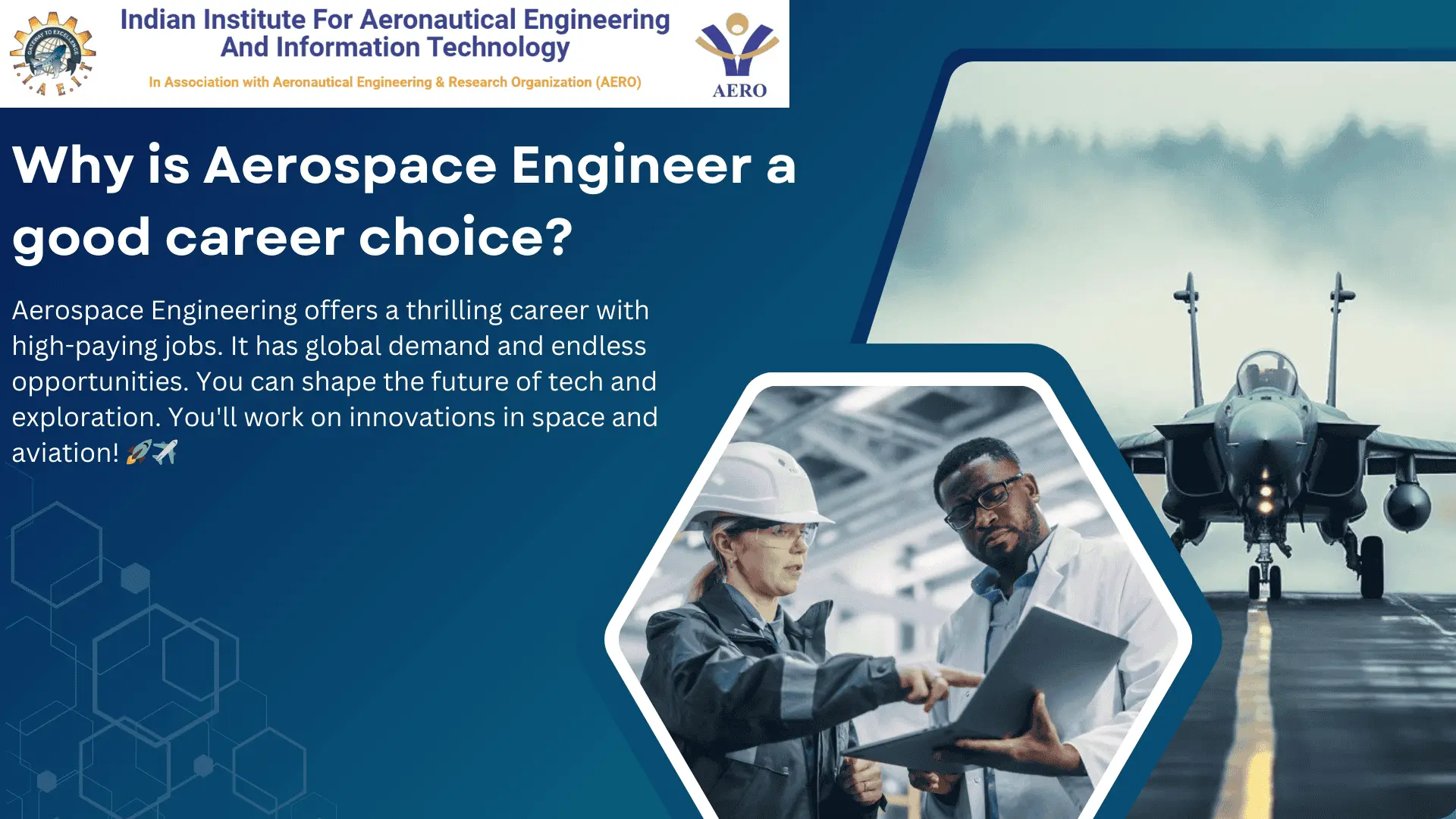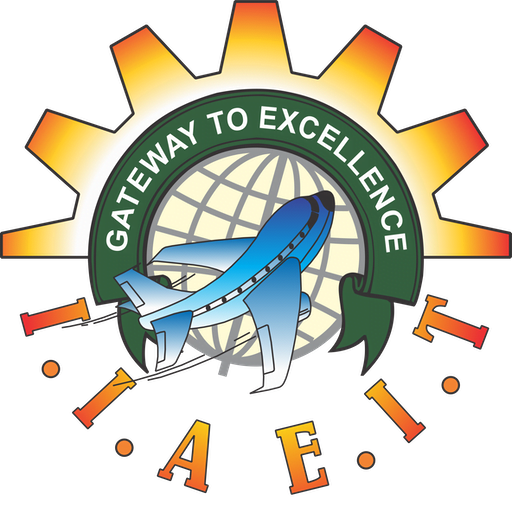Why is Aerospace Engineering a Good Career choice?
Reaching Beyond the Skies: Aerospace Engineering is a more than a career. It suits those who like technology, innovation, and exploration. It’s not about building planes and spacecraft. It’s about pushing the boundaries of what humanity can achieve.
Here’s why Aerospace engineering is a great career choice:
- Diverse Career Opportunities: Aerospace engineers work on cutting-edge technology in aviation, defense, and space. The possibilities are endless, from designing rockets and satellites to developing advanced drones. At IIAEIT, Pune, students learn practical skills in propulsion, Avionics, and aerodynamics. This prepares them for jobs at ISRO, HAL, and global giants like Airbus and Boeing.
- Global Demand: The Aerospace industry is growing not just in India but globally. There is a high demand for Aerospace engineers. This is due to advances in space tech, the rise of private space exploration, and a need for sustainable aviation. IIAEIT’s curriculum aligns with industry needs. It ensures graduates can excel anywhere in the world.
- Innovation and Exploration: If you want to help with missions like Chandrayaan or design eco-friendly aircraft, choose Aerospace engineering. At IIAEIT, students get hands-on training. They use state-of-the-art labs and a 52-seater aircraft. This practical experience turns their dreams into reality.
- High Earning Potential: Aerospace engineers are among the highest-paid engineers. There are lucrative jobs in both government and private sectors. IIAEIT graduates have strong industry connections. They help them get well-paying, impactful jobs.
- Impactful Career: Aerospace engineering lets you be part of something bigger. You can improve air travel safety or help with space exploration. IIAEIT instills not just technical skills but also a passion for innovation and excellence.
In short, Aerospace Engineering is a career of challenges, innovation, and global impact. With a degree from IIAEIT, you’re not just entering a profession—you’re launching a future in one of the most exciting fields of engineering!
Definition of Aerospace Engineering
(Complete Guide) Aerospace engineering focuses on designing, developing, and testing aircraft and spacecraft. This engineering discipline is crucial for advancements in both aeronautics (flight within Earth’s atmosphere) and astronautics (flight beyond Earth’s atmosphere). It encompasses multiple aspects, including materials science, structural design, propulsion and Avionics.
- Key Areas of Focus (Aeronautical vs. Astronautical)
- Aeronautical Engineering: Concentrates on vehicles that fly within the atmosphere, such as airplanes and helicopters.
- Astronautical Engineering: Deals with vehicles designed for space travel, including satellites and space probes.
- Differences from Related Fields (Mechanical Engineering, Aerodynamics) Similitude with Mechanical Engineering Unlike Aerospace engineering, a branch of ME, aeronautics is more focused. It is on specific areas, like fluid dynamics and materials under extremes. Also, its propulsion systems are more specialized than those in general engineering. So, there is a more specialized orientation toward air and space.
History Evolution
- Brief Timeline of Aerospace Innovations
The field has roots dating back to the early 20th century, with milestones like the Wright brothers’ first powered flight in 1903 and the launch of Sputnik in 1957, which marked the dawn of space exploration.
- Key Figures and Milestones in Aerospace Engineering
Innovators such as Amelia Earhart, Neil Armstrong, and Wernher von Braun made remarkable contributions, from enhancing aircraft technology to advancing rocket science. Their work has propelled the industry into new eras of capabilities.
- Impact of Space Exploration on the Discipline
The space race catalyzed rapid technological advancements and has kept Aerospace engineering at the forefront of innovation, influencing everything from telecommunications to meteorology.
Core Responsibilities of Aerospace Engineers
Design and Development of Aircraft and Spacecraft
Aerospace engineers play a crucial role in the design and development of advanced aircraft and spacecraft. At IIAEIT, students learn to work collaboratively, applying principles of aerodynamics, materials science, and structural engineering to create vehicles that are both efficient and safe. This meticulous design process ensures that each craft meets stringent industry standards for safety, performance, and environmental sustainability.
Testing and Evaluation Processes
Before any aircraft or spacecraft can take flight, it must undergo rigorous testing in controlled environments. IIAEIT’s Aerospace Engineering program emphasizes the importance of prototype testing to assess functionality, durability, and safety under real-world conditions. This critical phase is designed to identify potential issues early, helping engineers refine and enhance their designs to minimize risks and maximize reliability.
Educational Pathways for Aerospace Engineers
Required Degrees
To embark on a career in Aerospace engineering, a foundational Bachelor’s degree in Aerospace Engineering or a related field is essential. This degree covers core areas such as fluid dynamics, thermodynamics, and propulsion systems, equipping students with the knowledge needed to excel in the field. IIAEIT offers a robust Aerospace engineering curriculum that focuses on these key areas, preparing students for the demands of the industry. Advanced roles often require a Master’s degree, allowing engineers to specialize in fields like systems engineering or robotics, which can accelerate career growth and open doors to niche positions.
Certifications and Licenses
Certifications from recognized bodies, such as the Federal Aviation Administration (FAA), enhance job prospects by adding credibility to one’s credentials. IIAEIT encourages students to pursue relevant certifications that complement their academic achievements and set them apart in the competitive Aerospace job market.
Skills Development
- Technical Skills (CAD, Simulation Software, etc.)
Familiarity with tools such as Computer-Aided Design (CAD) and simulation software is vital in Aerospace engineering, as these tools ensure precision and efficiency in the design process. IIAEIT incorporates CAD and simulation training into its curriculum, allowing students to visualize and test concepts digitally, fostering a smooth transition into industry practice. - Soft Skills (Communication, Teamwork, Problem-Solving)
Aerospace projects involve multidisciplinary teams, making soft skills like communication, teamwork, and problem-solving critical. IIAEIT’s program emphasizes these interpersonal skills, training students to collaborate effectively and address challenges creatively. - Importance of Internships and Hands-On Experience
Practical experience is invaluable in Aerospace engineering. IIAEIT partners with industry leaders to provide internship opportunities that allow students to gain hands-on experience, develop crucial skills, and build professional networks that can lead to job offers upon graduation.
Relevant Coursework
- Core Subjects
Courses in fluid mechanics, materials science, and propulsion are integral to Aerospace engineering. These subjects form the backbone of IIAEIT’s curriculum, laying a solid foundation for students as they prepare for advanced applications in the industry. - Mathematics and Physics
A deep understanding of mathematics and physics is indispensable in Aerospace engineering, as they underpin the analysis of forces, energy, and structural integrity in Aerospace designs. IIAEIT places a strong emphasis on these areas, ensuring students are well-equipped for complex problem-solving tasks. - Competitive Electives
Elective courses in computer programming, project management, and emerging technologies help students differentiate themselves in the job market. IIAEIT offers a range of electives that prepare students for the ever-evolving demands of the Aerospace field, showcasing their adaptability and broadening their career prospects.
Job Market and Opportunities in Aerospace Engineering at IIAEIT
A. Current Trends in the Aerospace Industry
The Aerospace industry is expanding rapidly, with high demand for skilled engineers in commercial aviation, military, and space exploration. At IIAEIT, students are prepared to enter this dynamic market, where innovations like drone technology and electric aircraft are reshaping career opportunities. Future projections for the job market remain strong, driven by technological advances and a focus on sustainable Aerospace solutions, positioning IIAEIT graduates well for success.
B. Potential Career Paths
Graduates from IIAEIT can pursue diverse roles in airlines, defense contractors, and space agencies, with specialized training available in fields such as propulsion, structures, and Avionics. IIAEIT also emphasizes entrepreneurship, preparing students for consulting roles in regulatory compliance, safety standards, and new technology implementations—fields with growing demand in the industry.
C. Geographic Considerations
IIAEIT’s program prepares students for opportunities across major Aerospace hubs in regions like California, Texas, and Washington, where demand for Aerospace engineers is particularly high. With location influencing salary levels, IIAEIT encourages students to consider metropolitan areas, where opportunities and pay are often greater. Building a strong professional network through IIAEIT’s industry connections is invaluable, helping graduates access career-enhancing opportunities in the competitive Aerospace field.
Salary and Benefits for Aerospace Engineers: IIAEIT Graduates’ Outlook
Salary Expectations
- Starting Salaries: IIAEIT Aerospace Engineering graduates typically start at ₹6–8 lakhs annually, reflecting strong foundational skills.
- Growth with Experience: With specialization, salaries can exceed ₹15–20 lakhs per year, especially in high-demand areas like propulsion and systems engineering.
- Sector Variations: Salaries vary by sector; defense roles often pay more than commercial aviation due to technical demands.
Additional Benefits
- Career Stability and Growth: IIAEIT’s curriculum aligns with industry trends, preparing graduates for stable, growth-oriented careers.
- Comprehensive Packages: Benefits often include health insurance, retirement contributions, and bonuses, which IIAEIT helps students negotiate effectively.
- Continuous Learning: Employers frequently support ongoing training, certifications, and conferences, ensuring IIAEIT alumni stay competitive in a dynamic field.
Challenges of a Career in Aerospace Engineering
A. High Expectations and Competition
- The Rigor of Academic and Professional Standards – The stringent requirements for educational qualifications and professional performance create a highly competitive environment, prompting continuous self-improvement.
- Pressure to Deliver on Innovative Projects – Engineers often face high expectations to innovate and solve complex challenges, demanding creativity and technical prowess in equal measure.
- Competition for Top Jobs in Prestigious Organizations – Positions at leading Aerospace firms can be highly sought after, necessitating a standout skill set and network to secure these desirable openings.
B. Technological Changes
- Keeping Up with Rapid Advancements in Technology – Technological evolution is fast-paced, and engineers must commit to lifelong learning and stay abreast of the latest developments.
- Need for Continuous Education and Skill Upgrades – Engaging in continuous education through courses, certifications, and seminars is paramount to maintaining relevancy in a quickly changing field.
- Adaptation to New Tools and Methodologies – Familiarity with emerging software, tools, and processes is crucial for effective performance and innovation within the industry.
C. Market Volatility
- Influence of Economic Cycles on Job Security – Economic fluctuations can impact budgets in Aerospace projects, affecting hiring practices and job security.
- Effects of Government Funding and Policies on the Industry – Government contracts play a significant role in Aerospace employment; changes in funding can create waves of uncertainty within the sector.
- Challenges Posed by Global Competition – A competitive global landscape necessitates continuous innovation and efficiency improvements, increasing pressure on domestic engineers to maintain standards.
Conclusion
Aerospace engineering offers a rewarding career path that blends technical skills with innovative thinking. Engineers in this field contribute to advancements in air and space travel, playing crucial roles in shaping the future of aviation and space exploration. If you’re passionate about engineering the future of Aerospace, this career offers promising opportunities despite its challenges.
For those considering this path, institutions like IIAEIT provide comprehensive Aerospace engineering programs designed to equip students with the knowledge and hands-on skills needed for success. With cutting-edge labs and a curriculum focused on practical and theoretical knowledge, IIAEIT prepares graduates to make their mark in the Aerospace industry.
FAQ:
What degrees are required to become an Aerospace engineer?
A strong base for such a career is a bachelor’s degree in Aerospace engineering or a related field. Further specialization can be done with a master’s program.
What about the Aerospace engineers’ job market in the future years?
The industry’s outlook is bright. Different sectors tend to develop due to advances in technology and planned space exploration.
What are the differences between Aerospace engineering and other engineering disciplines?
Aerospace engineering is quite different from other engineering fields. This can be rewarding. It pays well and provides job satisfaction.
What are the most critical skills that students need to excel in the Aerospace engineering discipline?
These skills require knowledge of design and analysis. They also need strong problem-solving and communication skills in Aerospace engineering.
What sort of flexible work practices exist within Aerospace engineering jobs?
Most jobs require the employee to be at the worksite. However, some jobs, like research or design, may allow flexible hours or telecommuting.


